Bank exams test both speed and accuracy. Among reasoning topics, inequality stands out for its layered logic and the need for precision. Success depends not just on solving questions but also on understanding the reasoning behind each step.
Inequality questions become easier to master when each solution is broken down clearly. A structured PDF that offers detailed explanations helps learners pinpoint errors, recognize patterns, and refine their methods. This kind of guidance strengthens clarity and helps improve overall performance. To see how detailed solutions make a difference, consider these key areas.
Encourages Analytical Thinking Through Breakdown
Solving without understanding creates shallow knowledge. Bank-level reasoning questions are layered, and missing even one logical step can affect the final answer. Detailed solutions serve as guides, walking the learner through each comparison, symbol shift, and conclusion drawn.
This stepwise structure trains aspirants to trace logic backward. It strengthens their ability to identify where they might go wrong and, more importantly, how to avoid similar traps in future problems. When logic is broken down this way, retention becomes stronger, and the learning sticks better.
Helps Recognize Variations in Question Format
Every inequality question does not follow the same structure. Some include direct conclusions, while others require evaluating multiple inferences. Some are simple; others combine compound statements and reverse logic.
Inequality questions are discussed in detail, exposing candidates to all potential format twists. This prepares them to tackle a wider range of questions confidently. Over time, patterns become familiar, and even unusual types begin to feel manageable. Such familiarity plays a major role in reducing fear during real exam situations.
Boosts Accuracy with Error Analysis
Many learners make errors not because they lack ability but because they miss tiny details—like reversed symbols or improper inferences. There is no way to correct the error if the precise cause is unknown.
A detailed solution brings clarity to the point of error. It highlights the mistake directly and offers the correct path. This loop of error identification followed by immediate correction reinforces concepts better than blind repetition. Accuracy increases steadily, and so does confidence during timed practice.
Builds a Practice Routine That Feels Guided
One common struggle is the feeling of being lost while practicing alone. Without guidance, self-doubt creeps in. Well-explained practice files help eliminate confusion and offer a clearer direction during self-study. They provide a reference after every attempt, making solo practice feel more like a guided session.
Each practice set becomes a learning experience. When learners rely on structured explanations, they stop fearing complex problems and start building speed through logic, not guesswork. This support system keeps preparation consistent and productive, especially in the weeks closer to the exam.
The Quality of Study Resources Shapes the Final Outcome
The strength of preparation often mirrors the strength of the material used. When inequality questions are presented with precise structure and clean, understandable solutions, the learning becomes seamless. Low-quality content, in contrast, creates confusion and wastes time.
A reliable PDF is more than just a file—it becomes a foundation. High-quality explanations eliminate guesswork, saving mental effort and increasing conceptual depth. Well-prepared learners often owe their edge not to harder work but to smarter resources that make every effort count.
Inequality questions demand both speed and clarity, and detailed solutions offer a direct path to mastering both. They don’t just provide answers—they teach a way of thinking that becomes second nature over time. The more often aspirants engage with structured resources, the more they will be able to analyze patterns, predict traps, and solve problems with sharper logic.




